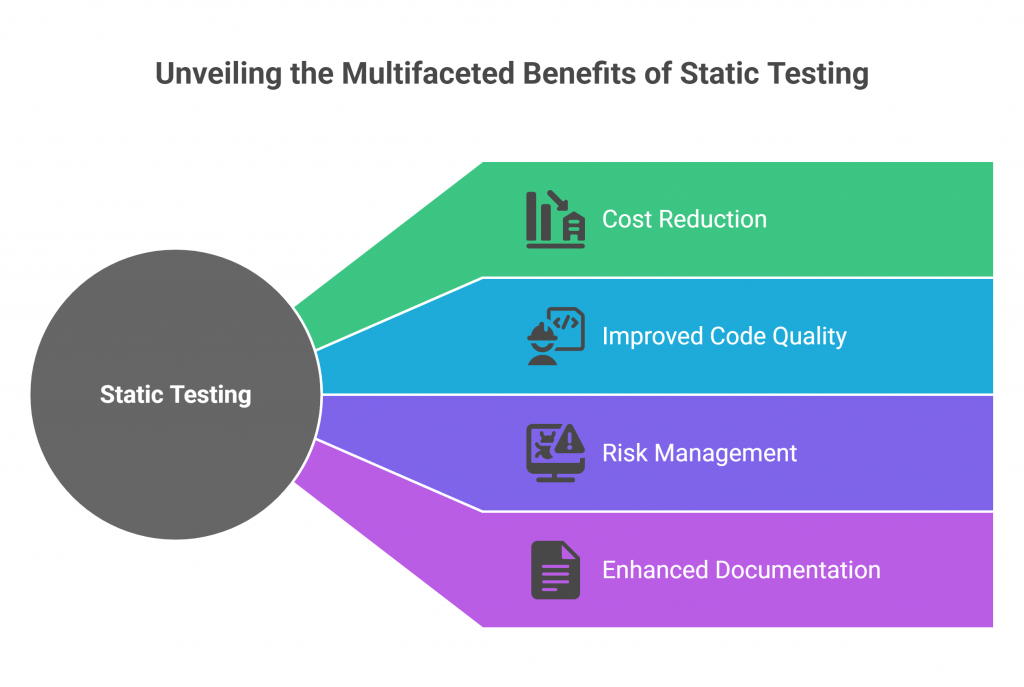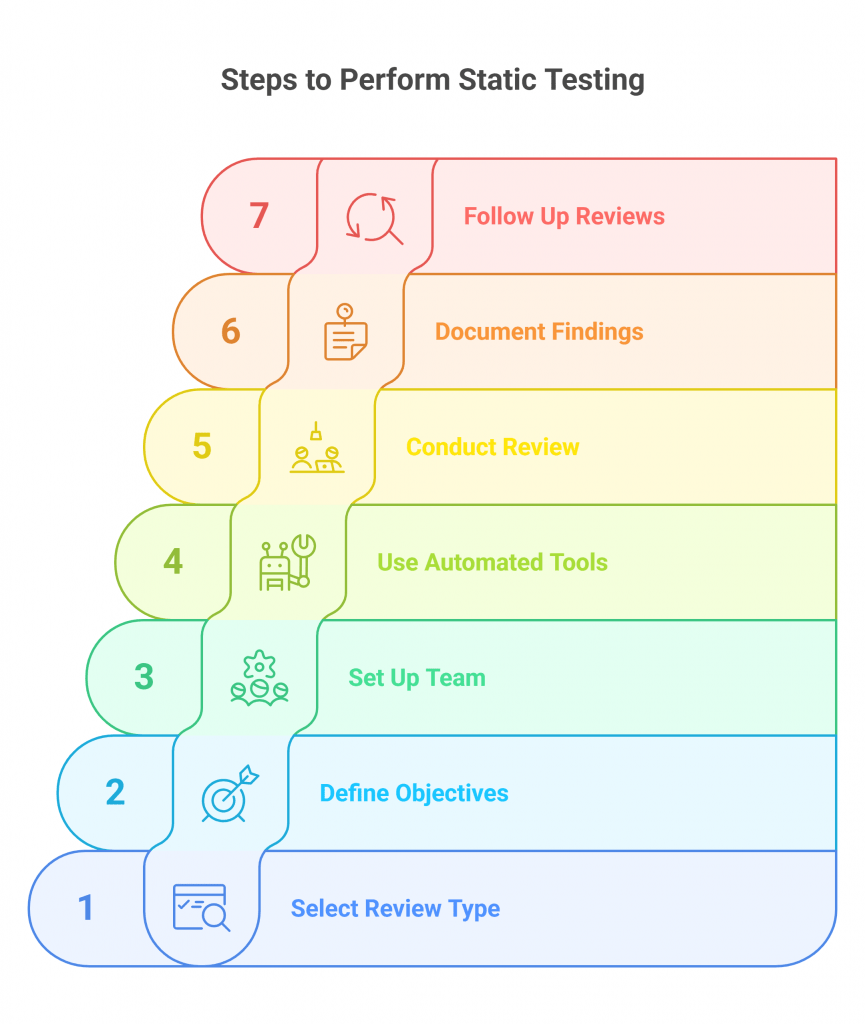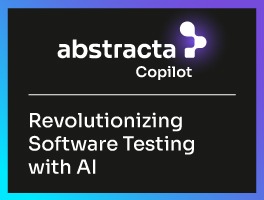Static testing vs dynamic testing seen through Abstracta’s mindset-first approach, where early review and predictive signals shape software quality from the start.


Static testing doesn’t begin with tools or checklists; It starts with a mindset. One that values clarity over speed and understands that quality emerges long before the first test case is executed.
At Abstracta, we’ve seen how this mindset transforms software teams, not just by finding defects sooner, but by reshaping how software is understood and written. We bring predictive AI into that mindset, helping teams surface risks they haven’t yet imagined and conversations they didn’t know they needed.
Over our 16+ years of experience, we have come to understand that we don’t need to test more, but to test earlier and prioritize with precision, with greater purpose.
Dive into the article to learn more about static testing vs dynamic testing!
Empower Your Testing Strategy with Abstracta’s AI-Enhanced Static Testing.
BOOK A MEETING
What Is Static Testing?
Static testing is a software testing method that examines documentation, requirements, and source code without executing the software. It proactively identifies errors, inconsistencies, and security vulnerabilities early in the software development lifecycle.
Key Aspects of Static Testing
- Verification from the Start
Static testing is applied during early stages of the software development process. It contributes to the verification process by allowing teams to evaluate structure, clarity, and alignment before any code is executed. - Cross-Functional Collaboration
QA analysts, developers, and stakeholders collaborate in walkthroughs and peer reviews, providing diverse perspectives that strengthen software integrity. - Automated Static Analysis Tools
Tools automatically scan source code, detecting syntax errors, dead code, and potential runtime exceptions like null pointer exceptions. At Abstracta, we enhance these tools using predictive AI, providing deeper, actionable insights. - Adherence to Standards
Code reviews enable alignment with coding standards and best practices, boosting software maintainability and readability.
Beyond Process: Why Static Testing Is a Mindset


Introducing static testing into a development team doesn’t just add a new stage to the lifecycle; it shifts how the team thinks. Teams that embrace it begin to ask better questions:
Is this code clear to someone reading it for the first time? Are the requirements internally coherent? Does this documentation reflect how we reason about this system?
In teams we’ve worked with, the impact is visible not only in fewer bugs, but in more thoughtful code, richer discussions during reviews, and a higher standard of accountability. Static testing becomes part of how teams think, not just what they do.
Better your Strategy with our Software Testing Maturity Model!
Benefits of Static Testing
Adopting static testing as part of your software testing strategy has measurable advantages:
- Cost Reduction
Early defect identification minimizes expenses associated with bug fixes, significantly reducing overall development costs. - Improved Code Quality
Consistent code reviews and automated analysis enhance code clarity, maintainability, and adherence to industry standards. - Risk Management
Early identification of potential security vulnerabilities helps validate if they are addressed promptly, reducing exposure to future risks. - Enhanced Documentation
Reviewing and verifying technical documentation early improves clarity and accuracy, reducing misunderstandings later.
Effective Static Testing Techniques
At Abstracta, our recommended static testing techniques include:
- Code Reviews
Manual or automated analysis by peers identifies coding errors, deviations from standards, and logical inconsistencies. - Automated Static Analysis
Static testing is often part of broader automated testing strategies. These tools systematically scan source code, pinpointing coding errors, security risks, dead code, and compliance violations. - Walkthroughs
Structured team sessions, guided by a moderator, examine documentation and source code collaboratively to detect potential defects. - Formal Inspections
Highly structured, formalized review sessions led by trained moderators foster thorough verification of software documentation and code. - Peer Reviews
Informal yet systematic feedback from team members identifies early-stage issues, encouraging continuous improvement in the development process.
Step by Step: How to Perform a Static Test?


To perform static testing effectively, teams need a clear structure. Here’s how teams can carry it out step by step, from preparing documentation to verifying that all findings are resolved.
What Do You Need Before Starting?
Gather the relevant source code, design documents, requirements specifications, and technical documentation. Define a checklist based on your team’s coding standards and security guidelines.
What Are the Steps?
- Select the Review Type
Choose between peer reviews, walkthroughs, inspections, or automated static analysis depending on the project stage and scope. - Define the Objectives and Scope
Clarify what aspects you want to evaluate—completeness, consistency, standards adherence, and security risks. - Set Up the Review Team
Assemble a group that includes developers, QA specialists, and domain experts to boost diverse insight. - Use Automated Tools When Appropriate
Tools help accelerate the detection of coding errors, especially for large or complex codebases. - Conduct the Review Session
Examine documents or code against the predefined checklist. Log defects clearly and assign them for resolution. - Document and Communicate Findings
Share findings in a standardized format. Use tools to track issues and their resolution over time. - Follow Up with Re-reviews
Once issues are resolved, continue reviewing as needed to validate improvements, reassess impacted areas, and sustain quality across iterations.
What Happens When the Code Runs: Introducing Dynamic Testing
Even when well-structured, static testing isn’t something you just complete and move on from. It feeds back into the way code evolves, how teams collaborate, and what gets prioritized next. To understand where it fits and what it doesn’t catch, we also need to consider what only surfaces once the code is running.
What is Dynamic Testing?
Unlike static testing, which inspects code and artifacts before execution, dynamic testing focuses on behavior. It reveals what the system actually does in real conditions—how it calculates, responds, interacts—through structured dynamic testing checks designed to validate real-world behavior. It’s how we catch defects that only appear with live data, complex flows, or unexpected inputs.
Dynamic Testing Techniques in Practice
Dynamic testing techniques are used to validate how software behaves under different conditions. These include:
- Unit testing: Validates individual components or functions in isolation.
- Integration Testing (SIT): Confirms that different modules or services interact as intended.
- System Testing: Examines the complete application to assess its compliance with specified requirements.
- User Acceptance Testing (UAT): Evaluates whether the system meets user expectations and business needs.
- Regression Testing: Checks that recent code changes have not negatively impacted existing functionality.
- Exploratory Testing: Involves testers actively probing the system to uncover unexpected behavior or gaps.
Static Testing vs Dynamic Testing
Static and dynamic testing differ not just in method, but in when and how they impact the software lifecycle. Understanding these contrasts helps teams design smarter, more balanced testing strategies.
| Feature | Static Testing | Dynamic Testing |
|---|---|---|
| When It Happens | Early stages of development | Inspections, walkthroughs, and static analysis tools |
| Execution Required | No | Yes |
| Focus | Code structure, documentation, design | Functional correctness, performance, behavior |
| Techniques | Syntax errors, logic flaws, and documentation issues | Unit, integration, system, acceptance testing |
| Defects Detected | High issues resolved before implementation | Runtime errors, interface issues, incorrect functionality |
| Cost Efficiency | Lower defects often costlier to fix post-implementation | Lower—defects often costlier to fix post-implementation |
| Tool Support | Static analyzers, linters, and documentation reviewers | Test automation frameworks, simulators, performance tools |
Abstracta’s Predictive Static Testing Approach
At Abstracta, we’ve developed a static testing approach that pushes past the limits of detection. It evolves with the codebase, learns from past reviews, and adapts to the patterns teams may not even be aware they’re repeating.
What Makes It Different?
We built an internal engine trained on thousands of documented defects and code review patterns across industries. That engine feeds into our static analysis layer, enabling us to surface not just issues that exist, but areas where issues are statistically likely to appear.
We pay attention to how code behaves over time. What modules change the most? Where complexity clusters? What kinds of issues show up again and again in certain contexts? These signals guide how we prioritize, focus, and iterate on static testing.
Components of our Static Testing Approach
- Data-driven prioritization
Each codebase is scored dynamically based on structural complexity, change history, and prior defect density. - Heatmap visualization
Reviewers see visual indicators highlighting sections of the code most at risk, improving focus and efficiency. - Contextual feedback loops
The system adapts based on reviewer input, closing the gap between AI-generated suggestions and human judgment. - CI-integrated risk alerts
Teams receive actionable warnings during code commits when the system detects likely defect regions.
Why It Matters
It’s a shift in how static testing becomes part of engineering culture. Teams catch issues faster, review with more precision, and build systems that reflect accumulated learning, not just isolated checks.
We’ve seen teams reduce post-release defect rates by over 30 percent while spending fewer hours per review. But more telling than the metrics is the shift in how those teams operate: reviews become more focused, code quality improves predictably, and knowledge flows more fluidly between people and systems. They evolve—technically and colaborativamente. And that’s not something you can replicate with a plugin.
How Our Mindset Scales: From Code to Culture


The real differentiator isn’t the tool, the method, or even the AI. It’s how teams internalize the mindset behind it. That mindset encourages teams to see review as design, clarity as non-negotiable, and testing as a conversation, not only a task.
In practice, we’ve seen teams shift from reactive fixes to proactive habits. They begin to write with review in mind. They challenge vague requirements. They optimize for function and also for understanding. That’s when static testing stops being a checkpoint and starts becoming part of the system’s DNA.
Conclusion: From Static Insight to Strategic Advantage
Static testing is no longer just a defensive practice; it’s a strategic lever. When empowered by predictive analytics and a deep understanding of code behavior, it becomes a tool for smarter decisions, earlier interventions, and stronger software products.
Our approach goes beyond simply comparing static vs dynamic testing; we prefer speaking about its role as a counterpart. Complemented by dynamic testing, which validates behaviors observable only at runtime, it enhances overall testing effectiveness.
At Abstracta, we’ve witnessed how organizations shift from reactive debugging to proactive quality engineering through our AI-enhanced static testing framework. But more than any tool, what powers those gains is mindset. A shared belief that clarity is worth the time, that reviews are about comprehension, not just correction. And that the best bugs are the ones never written.
FAQs About Static Testing vs Dynamic Testing


What Do You Mean by Static Testing?
Static testing is a software testing method that examines documentation, requirements, and source code without executing the software, proactively identifying errors early in development.
What Are the Main Static Testing Advantages?
Static testing advantages include early defect detection, cost reduction, improved code maintainability, and better collaboration between development and QA teams. It supports proactive quality and aligns closely with modern development practices.
What Are Common Static Testing Tools?
Static testing tools include linters, code analyzers, and documentation review utilities that help identify issues without executing code. These tools automate the detection of syntax errors, code smells, and security vulnerabilities during early stages of the software lifecycle.
What Is the Difference Between Static and Dynamic Testing?
Static testing involves no software execution and focuses on verifying documentation and source code. Dynamic testing executes software to validate actual behavior against expected outcomes.
How to Perform a Static Test?
Static testing is performed using techniques such as code reviews, automated static analysis tools, walkthroughs, inspections, and peer reviews to detect issues in documentation and code early.
Is Static Testing White Box Testing?
Static testing is considered a form of white-box testing as it involves analyzing internal source code and documentation to uncover defects without executing software code.
What Is Static Testing with an Example?
An example of static testing is developers conducting manual peer reviews of Java code to identify coding errors, standard deviations, and potential security vulnerabilities before code execution.
What Is an Example of Dynamic Testing?
Dynamic testing examples include unit tests where specific code modules are executed against test cases to validate functionality and boost correct outcomes.
How Does Static Testing Help Catch Errors Early in Development?
Static testing identifies defects at initial stages, allowing development teams to correct errors immediately, significantly reducing the time and cost involved in later-stage fixes.
What Are the Main Techniques Used in Static Testing Processes?
Static testing employs techniques such as code reviews, formal inspections, walkthroughs, peer reviews, and automated static analysis tools to systematically detect defects early.
Why Is Static Testing More Cost-Effective than Dynamic Testing?
Static testing detects defects early, reducing expenses associated with resolving bugs discovered in later stages, thereby lowering overall project costs.
Which Documents and Code Components Are Typically Reviewed During Static Testing?
Static testing reviews include source code, software requirements, design documents, technical documentation, and test scripts to stramline clarity, completeness, and correctness.
How Do Automated Tools Enhance the Effectiveness of Static Code Analysis?
Automated static analysis tools efficiently scan source code, swiftly detecting coding errors, dead code, security vulnerabilities, and coding standard deviations, significantly enhancing review effectiveness.
How We Can Help You


With over 16 years of experience and a global presence, Abstracta is a leading technology solutions company with offices in the United States, Chile, Colombia, and Uruguay. We specialize insoftware development, AI-driven solutions, and end-to-end software testing services.
Our expertise spans across industries. We believe that actively bonding ties propels us further and helps us enhance our clients’ software. That’s why we’ve built robust partnerships with industry leaders like Microsoft, Datadog, Tricentis, Perforce BlazeMeter, and Saucelabs to provide the latest in cutting-edge technology.
Curious as to which level your team lands for the different areas of quality? So don’t forget to take our free, online software testing maturity assessment!
Check our solutions and boost your test process improvement!


Follow us on Linkedin & X to be part of our community!
Recomended for You
What Is QA Testing? Differences with QE and Evolution
DORA Metrics in DevOps: Your Guide to Boosting IT Performance


Sofía Palamarchuk, Co-CEO at Abstracta
Related Posts
Clutch Awards: Abstracta, Global Leader for Spring 2024
Exciting News! We have been named one of the top global B2B companies in 2024 by Clutch Awards. It’s a recognition that highlights our commitment to excellence in software testing, custom software development, and AI-driven software solutions. In this new dawn, we are deeply enthusiastic…
TestingUY 2019 Recap: Bigger, Better, and All About Agile
What we took away from the Uruguayan testing conference we proudly sponsor each year This May, Montevideo hosted what felt like a party for testing in Latin America. In this sixth edition of TestingUy, the two day event gathered some 600 people from many parts of…
Search
Contents
Categories
- Acceptance testing
- Accessibility Testing
- AI
- API Testing
- Development
- DevOps
- Fintech
- Functional Software Testing
- Healthtech
- Mobile Testing
- Observability Testing
- Partners
- Performance Testing
- Press
- Quallity Engineering
- Security Testing
- Software Quality
- Software Testing
- Test Automation
- Testing Strategy
- Testing Tools
- Work Culture





